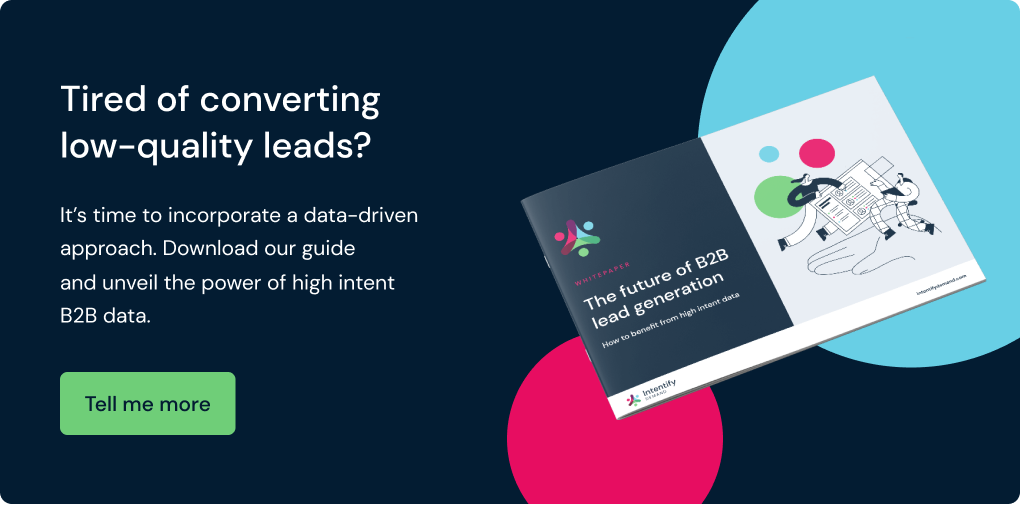Read time: 9 minutes
We all know how important the customer experience is, and in order to offer the best possible experience to your target audience, it’s vital that you understand key customer behaviours, patterns and buying habits.
Intent is a buzzword that has been treated with varying levels of credibility in the lead generation industry. This is due in large to the varying levels of integrity it has been implemented.
Once a phrase used by many to pique the interest of a prospective client with little substance follow, is now a prerequisite for marketing managers to explore new 3rd party lead provision.
– Kevin Ellis, Senior Sales and Strategy Director
Intent data, when used correctly, can provide you with valuable insights about the actions and interests of your target audience as they interact across multiple digital channels.
Armed with this information, you can better identify where prospects are on their buyer’s journey, empowering your marketing team to make informed decisions and take the right steps to increase conversation rates.
All of which can give you a competitive edge while saving you time, money and resources. In fact, two-thirds (65%) of marketing professionals say they plan to invest more in intent data this year.
Here is what intent data will look like in 2024 and why it’s no longer just a ‘nice-to-have’ tool.
What is intent data capable of right now?
We already understand that one of the biggest roles of intent data is to predict user intent - the clue is in the name - and therefore, determine how to target them.
But now, in 2024, including intent data in your marketing strategy can offer so much more than simply pushing an advert out in front of potential customers in a bid to win them over.
It’s no longer just about predicting what your target audience is doing and how they behave to make a sale.
I believe intent data will become more about individual buyer behaviour, which may include more detail around specific individuals and their profiling. If we can understand more about buying patterns or backgrounds to individuals and how they operate within their company, it might really help businesses with their outreach.
Selling to 'people' is so important, and messaging I feel in terms of outreach needs to be reflected from a lead gen perspective as much as it is from a cold outreach perspective.
– Will Smibert, CEO
Instead, predictive intent data makes it possible to ensure you're targeting the right people, at the right time and that you’re choosing the best possible way to communicate your message.
This means you can better allocate your marketing resources and achieve more impressive results.
The expectation of customers/consumers for personalised content (think Amazon’s recommendations for products or Netflix’s recommendations for films and tv shows) will bleed into the B2B buying world.
Decision makers and buying teams will expect tailored content and outreach from vendors. This will only be achievable by vendors if they have powerful intent targeting tools, otherwise they’ll only be guessing at what to do/say.
– George Montagu, Account Director
Think about it, the typical consumer doesn’t want to see an advert for their local pizza takeaway when they’re scrolling through Instagram at 8:00 AM over their morning coffee. They’ll simply ignore it.
Instead, they want to see it when it’s almost dinner time and they’re starting to feel hungry, as they’re already considering what to have for their evening meal.
Sure, this is a fairly rudimentary example, but you can see how predicting buyer intent is only the first step. You also have to target them at the perfect moment, with the right message if you hope to encourage profitable actions.
And this applies not just to purchasing goods or services, but also to encouraging your audience to complete other actions, such as signing up for a newsletter.
Except consumers are becoming increasingly bombarded with adverts based on their viewing or search history. So, although many marketing professionals have already begun to use AI for improved ad targeting, and 75% are using generative AI to produce content, this alone is not enough.
Enter AI intent data.
Intent and AI will become more of a focus but the hype isn't what will matter - marketers are paying closer attention to the details in AI technology in different solutions, and the technology that will make the difference in achieving higher conversion rates will rise to the top.
Status quo is dead, and performance will become more important as marketers grow impatient with non-transparent, inauthentic, and non- performing partners.
– Dina Baird, VP Sales and Strategy
Combining these valuable insights with AI, marketing professionals can determine customer intent, before they take an action. Meaning marketing and sales teams can offer support such as data-driven, pop-up chatbots that enhance the user experience by discussing an individual’s perceived needs or problems.
Other ways businesses can use intent data in 2024
We’ve already begun building a better understanding of what intent data is capable of and how these insights can be applied to your marketing strategy. However, there are several other key ways that businesses can utilise intent data this year:
- Providing higher quality sales leads - A staggering 94% of marketers say intent data leads are of higher quality than non-intent leads
- Increasing revenue growth – Being able to engage with leads more effectively will allow sales teams to close more deals and increase revenue
- Delivering relevant content - Providing the best possible marketing messages to the identified audiences
- Preventing churn - Recognising when customers are leaving your website to visit competitor sites and taking steps to find out why so you can prevent this from happening
- Encouraging departmental collaborations - Aligning your sales and marketing efforts for the best results to boost sales
Predictions for the year ahead
It’s clear intent data isn’t something marketers can ignore. In fact, intent data looks set to become a ‘must-have’ for marketing teams in 2024.
Investment in high-quality intent will increase
As we head into 2024 I think we will see the continued growth of investment into high-intent lead generation, particularly from the data owners. Typically, standalone intent companies have aggregated their intent from multiple 3rd party sources using a cookie-led approach. As cookies are becoming disabled alternative methods of intent gathering are emerging and true data owners rising in relevance.
In recent years the cost per lead has been driven down as lead generation providers tussle for the pennies from tightened purse strings. In 2024 I think we will start to see those purse strings slightly loosen as buyer confidence starts to return. As that happens, we will see marketers seek to spend more per lead with the expectation that the route to revenue will be shorter.
Whilst marketers will be happy to spend a higher cost for a high-intent lead, the scrutiny of the process will demand implied intent to be ascertained using multiple different sources. Gone are the days of a single content download counting as intent.
This increased demand for quality intent will see continued development of 1st party offerings, but also the ongoing development through mergers and acquisitions which has been on the rise since the pandemic.
- Kevin Ellis, Senior Sales and Strategy Director
Hyperpersonalisation will be expected
For 2024, I think we will see a significant rise in the use of intent data coupled with hyperpersonalisation.
Intent data provides accurate insights into what a person is seeking which then allows marketers to craft highly personalised messaging that resonates strongly with each potential buyer. However, as this practice becomes more common, people will increasingly expect personalised interactions as the norm.
Modern consumers prioritise quality over quantity and will be quick to seek alternatives if they see a lack of personalised experiences from businesses.
- Holly Jones, Marketing Manager
Delivering truly personalised experiences
A lot’s been said on utilising intent to drive higher-quality leads, with a better chance of conversion. For 2024, I see more focus on how we can utilise that technology/data to support pre- and post-campaign value. We’re working with a number of clients whose H1 objective is to further penetrate priority accounts.
Our AI and predictive technology allow us to focus on accounts showing only the highest levels of intent for our client’s solution, as well as targeting the right individuals within those accounts. Through our intent insights, we’re delivering messaging that’s not only relevant to their role but also to the specific challenge they may be facing.
Post-campaign, we’re working with marketing and sales teams to develop how they’re utilising the intent insights we’re delivering with the leads we generate. This can be as simple as delivering a relevant (i.e. intent-specific) asset for a second touch/nurture step.
Beyond this, SDR/BDR teams can use the intent insights to personalise their messaging, making it relevant to their specific focus area. Where clients are looking for multiple contacts within an account, providing sales with full visibility of the different intent topics and keywords across all individuals supports an ABM approach.
- El Bryant, Senior Sales Director
Intent-powered content will be everywhere
2024 is going to see some significant shifts in how B2B marketers approach content. With more AI-generated content appearing in the market and SEO predicted to take more of a back seat, intent is going to become the go-to tool for establishing brands as authorities.
While the approach to create content for the user is nothing new, this is going to become a key focus for brands looking to differentiate themselves. It’s not just about the blog anymore, but where and how can brands create content that stands out? Intent will have the answer.
Leveraging powerful insights, marketers will be able to pinpoint exactly how their target audience wants to interact with brands who will then be empowered to deliver.
- Natasha Vickery-Orme, Creative Content Director
Intent isn’t going anywhere
Global intent data tools are projected to witness substantial growth over the next few years, with estimates predicting the value of these tools will increase by 11.5% between 2020 and 2027.
This means the industry could be worth a staggering $6.5 billion by 2027.
What’s more, as AI becomes more sophisticated, the shift towards proactive customer engagement is going to be critical and intent data can play a pivotal role in its success.
If used correctly, this data can help your marketing team to encourage further engagement, boost conversions and foster customer loyalty in the long term.



